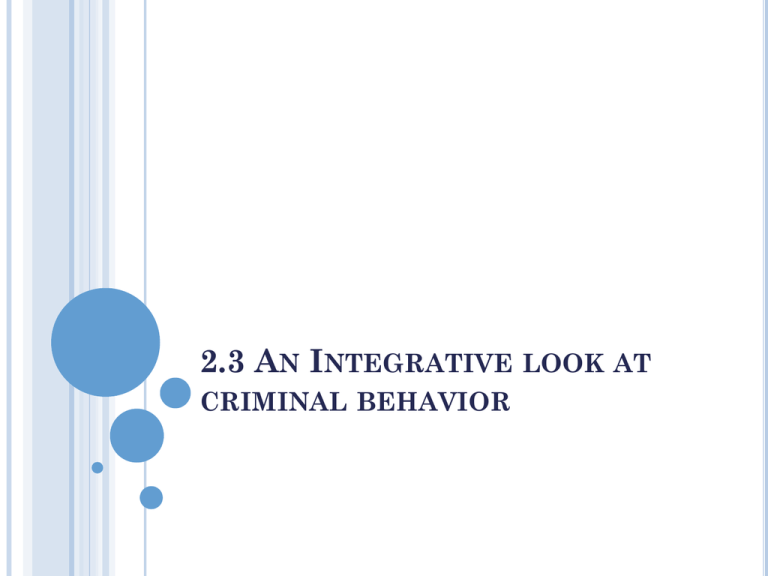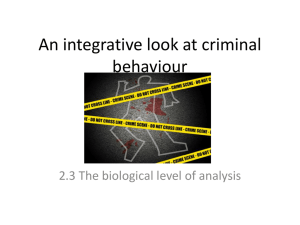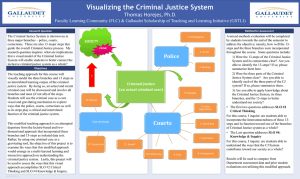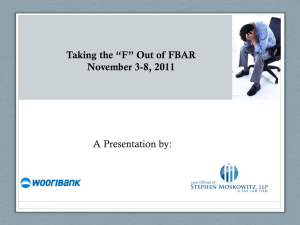2.3 An Integrative look at criminal behavior
advertisement

2.3 AN INTEGRATIVE LOOK AT CRIMINAL BEHAVIOR BIOLOGICAL LEVEL OF ANALYSIS Are some people born to be criminals? Is crime specific to ethnic groups, gender, physical characteristics? What is the biological, cognitive and sociocultural aspect of criminal behavior? ARE SOME PEOPLE BORN TO BE CRIMINALS? 3 biological theories Genetics Brain abnormalities Neurochemical imbalances GENETICS Crime runs in the family? Is this all genetic? Christiansen (1977) Twin study, (n=3586 sets) Found concordance (i.e. criminal activity) 35% MZ males twins 13% DZ male twins 21% MZ female twins 8% DZ female twins Are these concordance rates high or low? How would you evaluate the findings? (pg61) GENETICS CONT., Hutchings and Mednick (1975) If both the biological and adaptive fathers had a criminal record, then If only the biological father had a criminal record 11.5% sons had criminal record When neither father had a criminal record 21.4% sons had criminal record If only the adoptive father had a criminal record 36.2% sons also had criminal record 10.5 % of sons had criminal record What does this study demonstrate? 2 LIMITATIONS OF GENETIC ARGUMENTS What is the probability that there is a gene specific for criminal behavior? How do you evaluate criminal behavior? Criminal behavior follows age patterns, reaching peak when age 20 and declining at age 30. genetically speaking, why does this change over a lifetime? THE BRAIN Interrelationships between emotions and decision making. Emotions: controlled by limbic system Decisions: frontal lobe http://webspace.ship.edu/cgboer /limbicsystem.html http://www.stanford.edu/gr oup/hopes/cgibin/wordpress/2010/06/thehopes-brain-tutorial-textversion/#limbic-system INTERRELATIONSHIPS BETWEEN EMOTIONS AND DECISION MAKING. Blair et al. (1999): [key study sheet] Subject: brains of psychopath Method: Natural Procedure: PET Results: impairment of pathways between the amygdala and frontal lobe Conclusion: impairment makes it difficult for individuals to moderate their behavior. Frontal Brain Hypothesis A malfunctioning of the relationship between the frontal brain and the limbic system may cause criminal behavior. What about Brain Trauma? NEUROTRANSMITTERS AND HORMONES Is there a gender difference regarding criminal behavior? 90.1 % of apprehended murderers were male 82.1 % violent crimes committed by males (2004 US FBI report) What is the relationship with neurotransmitters? Low levels 5-HT Antisocial behavior impulsive Testosterone James Dabbs demonstrated higher levels of testosterone associated with increased violence. *note: these are correlations – does that show a cause and effect? ARE BIOLOGICAL FACTORS ALONE, ENOUGH TO ESTABLISH CAUSES FOR CRIMINAL BEHAVIOR? What if psychologist could determine that criminals have a biological predisposition towards their behavior? Should the courts be more lenient in enacting penalties? How would that affect the government view on the thought of punishment as a deterrent to crime? CRIMINAL BEHAVIOR: COGNITIVE LEVELS OF ANALYSIS YOCHELSON AND SAMENOW (1976) HOW DO CRIMINALS THINK? Cognitive distortions: an error in the way we process information. Blaming others fro your own failures Super-optomistism: extremely wishful or magical thinking. “I think, therefore it is” : not being able to accept mistakes Minimizing: limit the significance of a behavior to prevent taking responsibility for ones actions. Build up: exaggerating ones accomplishments to make ourselves look better in the eyes of others. This study only addressed criminal, i.e. it did not look at the non-criminal population. CORNISH AND CLARK (1987) Rational choice theory: criminal behavior is the outcome of a reasoned decision-making process. Criminals seek to benefit from their crimes. Cost to benefit analysis: Risk Financial reward Ease of breaking in * The results of this study were from burglars. CRIMINAL BEHAVIOR: THE SOCIOCULTURAL LEVELS OF ANALYSIS Social and culture expectations that people have on individuals. Economic and political realities POVERTY: MESSNER (1988) Are those who earn less more likely to commit crime? Messner found a high correlation between structural poverty and crime rate as opposed to income level and crime rate. Structural poverty – a holistic view of addressing criminal behavior and socioeconomic status. Single parent families Low levels of education High infant mortality Low social mobility POVERTY CONT., Unemployment and Crime? Social factors may interact with biological factors and lead to criminal behavior? Poverty and stress Stress and brain development LABELING AND SELF-FULFILLING PROPHECIES Self-fulfilling prophecy: we live up to the expectations or label that we are given. “Troublemaker” “rebel” “gangbanger” – does giving a person a label begin to hardwire them toward that characteristic? Jahoda’s (1954): Study on the Ashanti people of Ghana Ashanti custom of naming boys according to the day of the week they are born. A day of the week predicts a future temperament Monday = calm, reserved & peaceful Wednesday = problematic, aggressive. Boys born on Wednesday had a higher arrest record relative to boys born on Monday CRITICAL THINKING: Is criminal behavior primarily biologically based? To what extend do biological and sociocultural factors determine criminal behavior? What factors contribute most to criminal behavior – biological, sociocultural or cognitive? Article: Self Fulfilling Prophecy What other study did we address that looks at the self-fulfilling prophecy?









